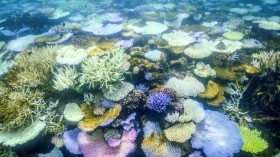A new study from the Woods Hole Oceanographic Institution (WHOI) may have cracked the elusive paradox involving the potent greenhouse gas methane that baffled many marine chemists for so long.
The study, published in the journal Nature Geosciences, showed that the mechanism behind the so-called "marine methane paradox" lie in the complex ways that bacteria break down dissolved organic matter.
The marine methane paradox is longstanding riddle that search for the origin of the methane in the surface water of the world's ocean if most of the microbes that can generate the greenhouse gas can't survive in oxygen-rich waters.
"All the pieces of this puzzle were there, but they were in different parts, with different people, in different labs, at different times," explained Dan Repeta, geochemists at WHOI and lead author of the study, in a press release. "This paper unifies a lot of those observations."
For the study, the researchers incubated seaweed bacteria under different conditions, adding nutrients such as glucose and nitrates at each batch. The researchers then added pure isolated polysaccharides in the mix. The bacteria quickly responded to the mix and began spitting large amounts of methane.
Repeta previously found polysaccharides in the samples of dissolved organic matter from surface waters in the Northern Pacific. These polysaccharides turn out to have similar pair of carbon and phosphorus atoms (C-P Bonds) as the man-made chemical methylphosphonate.
As the microbes break down the C-P bonds and munch on the phosphorus within the chemical, methane, ethylene and propylene gases are produced as byproducts. Most of the methane gas escapes back into the atmosphere.
With their findings, the researchers believe that the marine methane paradox involves two-part system. First, one species of microbes produced C-P bonds but can't use it, while another species utilized the C-P bonds but can't manufacture it. Additionally, the researchers note that breaking apart the C-P bonds to gain access to the phosphorus might be very difficult for the microbes, suggesting that the microbes might be forced to feed on the hard sources of nutrients after expending on the easier munch.
© 2024 NatureWorldNews.com All rights reserved. Do not reproduce without permission.

![Microplastics Escape Body's Gut to 'Infiltrate' the Brain, Kidneys and Liver [Study]](https://1471793142.rsc.cdn77.org/data/thumbs/full/70195/280/157/50/40/microplastics-escape-bodys-gut-to-infiltrate-the-brain-kidneys-and-liver-study.jpg)



